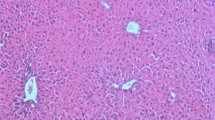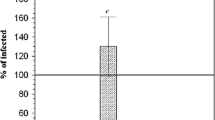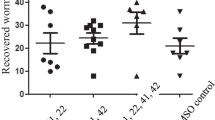Abstract
Conflicting reports are found in the literature about the antischistosomal efficacy of Mirazid (MZ), which is a special formulation of myrrh obtained from the stem of the plant Commiphora molmol. This initiated the present study to assess this drug for the first time in experimental schistosomiasis japonicum. Mice were divided into four groups: infected untreated control (I); infected treated with MZ, 500 mg/kg (II); infected treated with MZ, 250 mg/kg (III); and infected treated with praziquantel (PZQ), 200 mg/kg (IV). The drugs were given 7 weeks post-infection for five successive days. All animals were killed 3 weeks posttreatment. Results showed no signs of antibilharzial activity of MZ. Total worms, total tissue egg load, egg developmental stages, and granuloma area were not affected by any of the MZ treatment regimens as compared to the infected untreated group (P > 0.05 for all variables). These results were in contrast to those obtained in PZQ-treated animals in which 82.82 % total worm reduction, 94.62 % egg reduction, and 86.35 % granuloma area reduction were observed. Also, it significantly increased the percentage of dead ova and decreased the percentage of mature ova with complete absence of immature ones in comparison with the control group (P < 0.01 for all variables). In conclusion, the results of the current study raise serious doubts about the antischistosomal activity of MZ.
Similar content being viewed by others
References
Abdul-Ghani R, Loutfy N, EL-Sahan A, Hassan A (2009) Current chemotherapy arsenal for schistosomiasis mansoni alternatives and challenges. Parasitol Res 104:955–965
Abo-Madyan AA, Morsy TA, Motawea SM (2004) Efficacy of myrrh in the treatment of schistosomiasis (haematobium and mansoni) in Ezbet El-Bakly, Tamyia Center, El-Fayoum Governorate, Egypt. J Egypt Soc Parasitol 34:423–446
Al Harbi MM, Qureshi S, Ahmed MM, Rafatulla S, Shah AH (1994) Effect of Commiphora molmol (oleo-gum-resin) on cytological and biochemical changes induced by cyclophosphamide in mice. Am J Chin Med 22:77–82
Allam AF, El-Sayed MH, Khalil SS (2001) Laboratory assessment of the molluscicidal activity of Commiphora molmol (Mirazid) on Biomphalaria alexendrina, Bulinus truncates and Lymnaea caillaudi. J Egypt Soc Parasitol 31(3):683–690
Al-Mathal AM, Fouad MA (2004) Myrrh (Commiphora molmol) in treatment of human and sheep dicrocoeliasis dendriticum in Saudi Arabia. J Egypt Soc Parasitol 34(2):713–720
Badria F, Abou-Mohamed G, El-Mowafy A, Masoud A, Salama O (2001) Mirazid: a new schistosomicidal drug. Pharm Biol 39:127–131
Baghdadi HB, Al-Mathal EM (2010) Anti-coccidial effect of Commiphora molmol in the domestic rabbit (Oryctolagus cuniculus domesticus L.) J Egypt Soc Parasitol 40(3):653–668
Barakat R, Elmorshedy H, Fenwick A (2005) Efficacy of myrrh in the treatment of human schistosomiasis mansoni. AmJTrop Med Hyg 73(2):365–367
Botros S, William S, Ebeid F, Cioli D, Katz N, Day T, Bennett J (2004) Lack of evidence for an antischistosomal activity of myrrh in experimental animals. AmJTrop Med Hyg 71:206–210
Caffrey CR (2007) Chemotherapy of schistosomiasis: present and future. Curr Opin Chem Biol 11:433–439
Cheever AW (1968) Conditions affecting the accuracy of potassium hydroxide digestion techniques for counting Schistosoma mansoni eggs in tissues. Bull World Health Organ 39:328–331
Claeson P, Anderson R, Samuelsson G (1991) T-cardinal a pharmacologically constituent of secreted myrrh: introductory pharmacological characterization and high field 1H- and 13C-NMR data. Planta Med 57:352–356
Doenhoff MJ, Cioli D, Utzinger J (2008) Praziquantel: mechanisms of action, resistance and new derivatives for schistosomiasis. Curr Opin Infect Dis 21:659–667
El Baz MA, Morsy TA, El Bandary MM, Motawea SM (2003) Clinical and parasitological studies on the efficacy of Mirazid in treatment of schistosomiasis haematobium in Tatoon, Etsa Center, El Fayoum Governorate. J Egypt Soc Parasitol 33:761–767
Fathy FM, Salama O, Massoud AM (2005) Effect of Mirazid (Commiphora molmol) on experimental heterophyidiasis. J Egypt Soc Parasitol 35(3):1037–1050
Ford RA, Api AM, Letizia CS (1992) Monographs on fragrance to raw materials. Food Chem Toxicol 30(Suppl):1S–138S
Greene DA (1993) Gold, frankincense, myrrh, and medicine. N C Med J 54:620–622
Hamed MA, Hetta MH (2005) Efficacy of Citrus reticulata and Mirazid in treatment of Schistosoma mansoni. Mem Inst Oswaldo Cruz 100(7):771–778
Haridy FM, Dawoud HA, Morsy TA (2004) Efficacy of Commiphora molmol (Mirazid) against sheep naturally infected with monieziasis expansa in Al-Santa Center, Gharbia Governorate, Egypt. J Egypt Soc Parasitol 34(3):775–782
Jain SK (1994) Ethnobotany and research on medical plants in India. CIBA Found Symp 185:153–168
King CH, Dangerfield-Cha M (2008) The unacknowledged impact of chronic schistosomiasis. Chronic Illn 4:65–79
Lee Y, Lam TH (1993) Allergic contact dermatitis due to Chinese orthopedic solution tieh ta yao gin. Contact Dermatitis 28:89–90
Massoud AM, Habib FS (2003) The effect of myrrh Commiphora molmol on the infected snails with Schistosoma sp. and their egg masses: effect on shedding of cercariae and on snail fecundity. J Egypt Soc Parasitol 33(2):585–596
Massoud AM, Labib IM (2000) Larvicidal activity of Commiphora molmol against Culex pipiens and Aedes caspius larvae. J Egypt Soc Parasitol 30(1):101–115
Massoud AM, El Sisi S, Salama O (2001) Preliminary study of therapeutic efficacy of a new fasciolicidal drug derived from Commiphora molmol (myrrh). AmJTrop Med Hyg 65(2):96–99
Massoud AM, Morsy TA, Haridy FM (2003) Treatment of dicrocoeliasis in man and animals with Mirazid. J Egypt Soc Parasitol 33(2):437–442
Massoud AM, El Ebiary FH, Abdel Salam NF (2004) Effect of myrrh extract on the liver of normal and bilharzially infected mice an ultrastructure study. J Egypt Soc Parasitol 34(1):1–21
Massoud AM, El-Shazly AM, Morsy TA (2007) Mirazid (Commiphora molmol) in treatment of human heterophyiasis. J Egypt Soc Parasitol 37(2):395–410
Michie CA, Cooper E (1991) Frankincense and myrrh as remedies in children. J R Soc Med 84:602–605
Osman MM, El-Taweel HA, Shehab AY, Farag HF (2010) Ineffectiveness of myrrh-derivative Mirazid against schistosomiasis and fascioliasis in humans. East Mediterr Health J 16(9):932–936
Pellegrino J, Oliveira CA, Faria J, Cunha A (1962) New approach to the screening of drugs in experimental Schistosoma mansoni in mice. AmJTrop Med Hyg 11:201–215
Pellegrino J, Lima-Costa FF, Carlos ML, Mello RT (1977) Experimental chemotherapy of schistosomiasis mansoni. Parasitol Res 52:151–168
Ramzy F, Mahmoud S, William S (2010) Further assessment of Mirazid as antischistosomal drug in experimental schistosomiasis hematobium. Pharm Biol 48(7):775–779
Ribeiro-dos-Santos G, Verjovski-Almeida S, Leite LCC (2006) Schistosomiasis—a century searching for chemotherapeutic drugs. Parasitol Res 99:505–521
Sheir Z, Nasr A, Massoud A, Salama O, Badra GA, El-Shennawy H, Hassan N, Hammad S (2001) A safe and effective, herbal antischistosomal therapy derived from myrrh. AmJTrop Med Hyg 65:700–704
Smithers SR, Terry RT (1965) Infection of laboratory hosts with cercaria of Schistosoma mansoni and the recovery of adult worms. Parasitology 55:695–700
Soliman OE, El-Arman M, Abdul-Samie ER, El-Nemr HI, Massoud A (2004) Evaluation of myrrh (Mirazid) therapy in fascioliasis and intestinal schistosomiasis in children: immunological and parasitological study. J Egypt Soc Parasitol 34(3):941–966
Steinmann P, Keiser J, Bos R, Tanner M, Utzinger J (2006) Schistosomiasis and water resources development: systematic review, meta-analysis, and estimates of people at risk. Lancet Infect Dis 6:411–425
Acknowledgments
Mohamed EL-Malky was awarded a grant by Short-term Invitation Program of Japan Student Services Organization.
Author information
Authors and Affiliations
Corresponding author
Rights and permissions
About this article
Cite this article
EL-Malky, M.A., Lu, Sh., El-Beshbishi, S.N. et al. Effect of Mirazid in Schistosoma japonicum-infected mice: parasitological and pathological assessment. Parasitol Res 112, 373–377 (2013). https://doi.org/10.1007/s00436-012-3145-x
Received:
Accepted:
Published:
Issue Date:
DOI: https://doi.org/10.1007/s00436-012-3145-x




